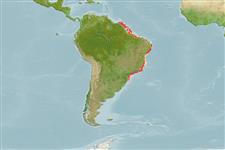Environment: milieu / climate zone / depth range / distribution range
Ecologia
marino; acqua dolce; salmastro demersale; distribuzione batimetrica 1 - 16 m (Ref. 36453). Tropical; 7°N - 29°S, 55°W - 30°W
Western Atlantic: Suriname to Brazil.
Size / Peso / Age
Maturity: Lm ? range ? - ? cm
Max length : 20.5 cm TL maschio/sesso non determinato; (Ref. 102462); common length : 12.0 cm TL maschio/sesso non determinato; (Ref. 5217); peso massimo pubblicato: 177.96 g (Ref. 102462)
Short description
Morfologia | Morfometria
Spine dorsali (totale): 0; Raggi dorsali molli (totale): 55-60; Spine anali 0; Raggi anali molli: 40 - 44. Pectorals either vestigial or reduced to 1-2 rudimentary rays (Ref. 36453).
Found more abundantly on shallow soft bottoms of brackish estuaries or hypersaline lagoons. Enters freshwaters at least to an elevation of 10 m. Inhabits rivers and creeks and probably feeds on aquatic insects and crustaceans (Ref. 36880).
Life cycle and mating behavior
Maturità | Riproduzione | Deposizione | Uova | Fecundity | Larve
Cervigón, F., R. Cipriani, W. Fischer, L. Garibaldi, M. Hendrickx, A.J. Lemus, R. Márquez, J.M. Poutiers, G. Robaina and B. Rodriguez, 1992. Fichas FAO de identificación de especies para los fines de la pesca. Guía de campo de las especies comerciales marinas y de aquas salobres de la costa septentrional de Sur América. FAO, Rome. 513 p. Preparado con el financiamento de la Comisión de Comunidades Europeas y de NORAD. (Ref. 5217)
IUCN Red List Status (Ref. 130435)
Threat to humans
Harmless
Human uses
Informazioni ulteriori
Nomi ComuniSinonimiMetabolismoPredatoriEcotossicologiaRiproduzioneMaturitàDeposizioneSpawning aggregationFecundityUovaEgg development
BibliografiaAcquacolturaProfilo di acquacolturaVarietàGeneticaElectrophoresesEreditarietàMalattieElaborazioneNutrientsMass conversion
Strumenti
Special reports
Download XML
Fonti Internet
Estimates based on models
Preferred temperature (Ref.
123201): 22.6 - 28.1, mean 27.5 °C (based on 223 cells).
Phylogenetic diversity index (Ref.
82804): PD
50 = 0.5010 [Uniqueness, from 0.5 = low to 2.0 = high].
Bayesian length-weight: a=0.01148 (0.00909 - 0.01450), b=3.13 (3.06 - 3.20), in cm total length, based on LWR estimates for this species (Ref.
93245).
Trophic level (Ref.
69278): 3.3 ±0.45 se; based on food items.
Resilienza (Ref.
120179): Alto, tempo minimo di raddoppiamento della popolazione meno di 15 mesi (Preliminary K or Fecundity.).
Fishing Vulnerability (Ref.
59153): Low vulnerability (11 of 100).
Nutrients (Ref.
124155): Calcium = 255 [117, 432] mg/100g; Iron = 1.15 [0.57, 2.18] mg/100g; Protein = 17.6 [16.3, 19.0] %; Omega3 = 0.133 [0.061, 0.267] g/100g; Selenium = 35 [17, 74] μg/100g; VitaminA = 19.4 [6.3, 58.6] μg/100g; Zinc = 1.52 [1.01, 2.20] mg/100g (wet weight);
